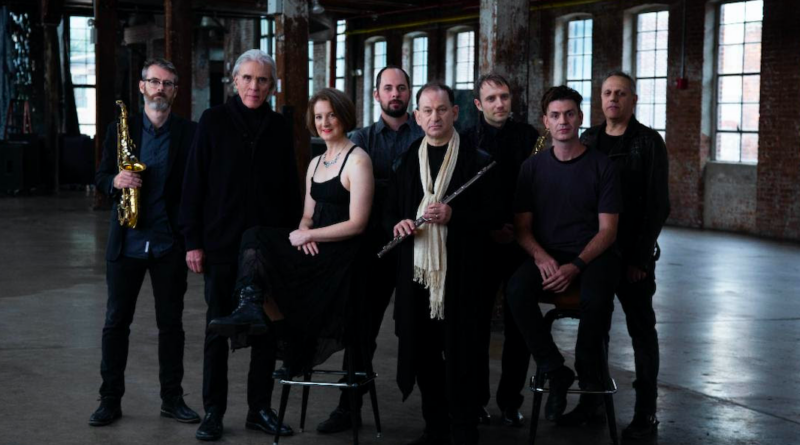INTERVIEW: Andrew Sterman on the prescience of ‘Naqoyqatsi’
Photo: The Philip Glass Ensemble will perform the live score of Naqoyqatsi at The Town Hall. Photo courtesy of Ryuhei Shindo / Provided by Cindy Byram PR with permission.
On Saturday, April 19, the Philip Glass Ensemble, along with cellist extraordinaire Matt Haimovitz, will offer audiences a rare sonic and visual treat at The Town Hall in Midtown Manhattan. They will bring to life the film score to Naqoyqatsi, the third and final film in the expansive cinematic trilogy directed by Godfrey Reggio, with music composed by Glass himself. The ensemble will play the music live while the film is broadcast on a screen — and what a film it is. This nonlinear documentary explores the transition from natural environments to a landscape dominated by technology, computer graphics and digital images, according to press notes. Although Naqoyqatsi is more than two decades old, the movie feels eerily prescient and of the minute.
“It’s exciting,” said Andrew Sterman, general manager and performing member of the Philip Glass Ensemble. “It is rare [to screen this movie]. The last time in New York was shortly after it was composed. It’s got to be 20 years ago.”
Sterman said this film feels very much like the third part of a trilogy, though one doesn’t have to see the first two parts — Koyaanisqatsi and Powaqqatsi — to understand this final chapter. “There is a number of years between each production of each film,” the tenor saxophonist said. “It was always conceived as a trilogy. It’s quite interesting. Film is different than just plain concerts. … Film is the modern opera.”
Naqoyqatsi is an example of an early digital wrk, with Reggio and Glass being on the forefront of the digital revolution that was to come. What sets the film apart is that it uses digital technology, but also it’s inherently about digital technology and how humans interact with this evolving frontier. The documentary has no narration, characters or dialogue; instead, the poetic essay is built around image and sound, with the audience being asked to find connections and put the puzzle pieces together.
“The film was being made before 9/11 happened,” Sterman said. “It was almost too much to look at when it did come out. … I remember when we were working on it and going to see the premiere showing in New York City that everything was just so raw, and it was difficult. It was very heavy to watch.”
The film’s title is loosely translated from the Hopi as “civilized violence,” and perhaps this unfiltered look at war and bleakness, all with a backdrop of digital technology, was a difficult ask in the months following the terrorist attacks of 2001.
“I think we haven’t got used to any of the stuff, but we’ve matured in a way as a culture that we know there’s a lot of crazy things going on, awful things,” said Sterman, who has been with the Philip Glass Ensemble since the early-1990s. “We know that no one is flawless in the equation, and it’s a very different world than it was in 2000 before 9/11 happened. So Godfrey saw these things in advance. He occasionally does talk about how the film was difficult to put out around that time, but that doesn’t mean he apologizes for it. It wasn’t wrong; it actually was prescient. All three concert films, they’re ahead of their times, and it is more pertinent than ever — absolutely. And this is something that many, many people say to us after we’ve performed one of the Qatsi films. ‘I understand that it was made a while ago, but rather than seeming dated, it just seems like it was forward-looking in an incredible way.’”
Even Sterman is amazed by how prophetic this cinematic trilogy has proved to be, and he questions how Reggio and Glass were able to anticipate changes in society and culture. After all, they began working on this decades-long project back in the 1980s, yet the images and ponderings still feel fresh in 2025.
“[Reggio] wants to talk to everybody, all of us, and he’s always been very clear about that,” Sterman said. “The way I understood the legend, he was not a filmmaker, and he wanted to reach people. He said, ‘What is the medium for America?’ You could say television, but he said, ‘No, film. It’s got to be film.’ And Koyaanisqatsi was his first film. It’s a well-accepted masterpiece. The connection that he and Philip developed making these films is extraordinary. The music and the visual film are more integrated than any other works of film I can think of. And, of course, there are many films with great music, but the integration is through and through and through.”
Sterman added: “Normally in making the films, the film is done, it’s produced, it’s edited, it’s buffed up, all the pacings are set, and then it’s given to the composer as the last thing. And very often — and I can tell you this as a musician who has played on many film scores and recordings — it can be a race between the end of the film and composing and recording music in order to get it out as fast as possible so money doesn’t spill away. It’s always a rush to do the film score, and in these, Philip and Godfrey worked together from the beginning. So Koyaanisqatsi, they were working on it for a couple of years together, back and forth and back and forth. In fact, one of the great things about the Qatsis is the trust that Godfrey and Philip have for each other. Basically Philip would write music, and his pacing is so sophisticated that the pacing of the music would then become the pacing of the film. Like, this section of music takes this long to unfold, and Godfrey would cut that section of the film to that section of music, rather than the usual other way.”
That collaboration, which is now legendary, has given the world three films that are utterly unique and profoundly prescient.
By John Soltes / Publisher / John@HollywoodSoapbox.com
The Philip Glass Ensemble will perform the live score to a screening of Naqoyqatsi on Saturday, April 19, at The Town Hall in New York City. Click here for more information and tickets.

